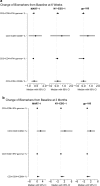Long term impact of CTLA4 blockade immunotherapy on regulatory and effector immune responses in patients with melanoma
- PMID: 29973204
- PMCID: PMC6033230
- DOI: 10.1186/s12967-018-1563-y
Long term impact of CTLA4 blockade immunotherapy on regulatory and effector immune responses in patients with melanoma
Abstract
Background: We previously reported early on-treatment significant modulation in circulating regulatory T cell (Treg), myeloid derived suppressor cells (MDSC) and antigen-specific type I CD4+ and CD8+ T cells that correlated with clinical outcome in regionally advanced melanoma patients treated with neoadjuvant ipilimumab. Here, we investigated the long term immunologic impact of CTLA4 blockade.
Methods: Patients were treated with ipilimumab given at 10 mg/kg IV every 3 weeks for 2 doses bracketing surgery. Blood specimens were collected at baseline and during treatment for up to 9 months. We tested immune responses at 3, 6, and 9 months utilizing multicolor flow cytometry. We compared frequencies of circulating Treg and MDSC on-study to baseline levels, as well as frequencies of CD4+ and CD8+ T cells specific to shared tumor-associated antigens (Gp-100, MART-1, NY-ESO-1).
Results: Levels of Treg significantly increased when measured at 6 weeks following ipilimumab but returned to baseline by 3 months, with no significant difference in Treg levels between relapsed and relapse-free groups at 3, 6 or 9 months. However, lower baseline levels of circulating Treg (CD4+CD25hi+CD39+) were significantly associated with better relapse free survival (RFS) (p = 0.04). Levels of circulating monocytic HLA-DR+/loCD14+ MDSC were lower at baseline in the relapse-free group and further decreased at 6 weeks, though the differences did not reach statistical significance including measurements at 3, 6 or 9 months. We detected evidence of type I (interferon-γ producing), activated (CD69+) CD4+ and CD8+ antigen-specific T cell immunity against cancer-testis (NY-ESO-1) as well as melanocytic lineage (MART-1, gp100) antigens in the absence of therapeutic vaccination. These responses were significantly boosted at 6 weeks and persisted at 3, 6 and 9 months following the initiation of ipilimumab.
Conclusions: Lower Treg levels at baseline are significantly associated with RFS and increased Treg frequency after CTLA4 blockade was only transient. Lower MDSC was also associated with RFS and MDSC levels were further decreased after ipilimumab. Tumor specific effector immune responses are boosted with CTLA4 blockade and tend to be durable. Trial registration ClinicalTrials.gov Identifier: NCT00972933.
Keywords: CTLA4; Ipilimumab; MDSC; Melanoma; Regulatory T cells; Tumor antigens.
Figures






Similar articles
-
Immune monitoring of the circulation and the tumor microenvironment in patients with regionally advanced melanoma receiving neoadjuvant ipilimumab.PLoS One. 2014 Feb 3;9(2):e87705. doi: 10.1371/journal.pone.0087705. eCollection 2014. PLoS One. 2014. PMID: 24498358 Free PMC article.
-
Melanoma antigen-specific effector T cell cytokine secretion patterns in patients treated with ipilimumab.J Transl Med. 2017 Feb 21;15(1):39. doi: 10.1186/s12967-017-1140-9. J Transl Med. 2017. PMID: 28222797 Free PMC article. Clinical Trial.
-
Differing patterns of circulating regulatory T cells and myeloid-derived suppressor cells in metastatic melanoma patients receiving anti-CTLA4 antibody and interferon-α or TLR-9 agonist and GM-CSF with peptide vaccination.J Immunother. 2012 Nov-Dec;35(9):702-10. doi: 10.1097/CJI.0b013e318272569b. J Immunother. 2012. PMID: 23090079 Free PMC article.
-
CTLA-4 blockade increases antigen-specific CD8(+) T cells in prevaccinated patients with melanoma: three cases.Cancer Immunol Immunother. 2011 Aug;60(8):1137-46. doi: 10.1007/s00262-011-1011-9. Epub 2011 Apr 5. Cancer Immunol Immunother. 2011. PMID: 21465316 Free PMC article. Review.
-
Immune modulations during chemoimmunotherapy & novel vaccine strategies--in metastatic melanoma and non small-cell lung cancer.Dan Med J. 2013 Dec;60(12):B4774. Dan Med J. 2013. PMID: 24355457 Review.
Cited by
-
Hallmarks of response, resistance, and toxicity to immune checkpoint blockade.Cell. 2021 Oct 14;184(21):5309-5337. doi: 10.1016/j.cell.2021.09.020. Epub 2021 Oct 7. Cell. 2021. PMID: 34624224 Free PMC article. Review.
-
Myeloid Cells as Clinical Biomarkers for Immune Checkpoint Blockade.Front Immunol. 2020 Jul 24;11:1590. doi: 10.3389/fimmu.2020.01590. eCollection 2020. Front Immunol. 2020. PMID: 32793228 Free PMC article. Review.
-
Location matters: spatial dynamics of tumor-infiltrating T cell subsets is prognostic in colon cancer.Front Immunol. 2024 Feb 5;15:1293618. doi: 10.3389/fimmu.2024.1293618. eCollection 2024. Front Immunol. 2024. PMID: 38375478 Free PMC article.
-
"To Anticipate": Neoadjuvant Therapy in Melanoma with a Focus on Predictive Biomarkers.Cancers (Basel). 2020 Jul 17;12(7):1941. doi: 10.3390/cancers12071941. Cancers (Basel). 2020. PMID: 32708968 Free PMC article. Review.
-
Targeting T regulatory (Treg) cells in immunotherapy-resistant cancers.Cancer Drug Resist. 2024 Jan 12;7:2. doi: 10.20517/cdr.2023.46. eCollection 2024. Cancer Drug Resist. 2024. PMID: 38318526 Free PMC article. Review.
References
Publication types
MeSH terms
Substances
Associated data
Grants and funding
LinkOut - more resources
Full Text Sources
Other Literature Sources
Medical
Research Materials

